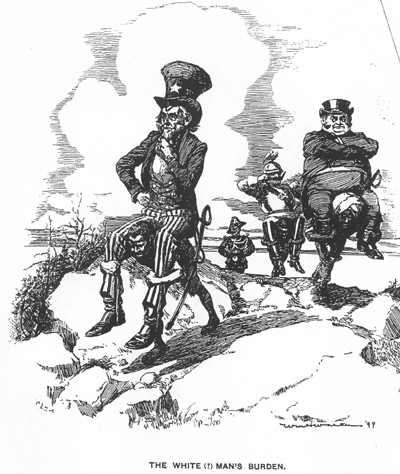An American Empire
Until the 1890s, America prided itself for its isolation from world affairs. Territorial ambitions and visions of empire were limited to westward expansion across the American continent. But in the 1890s, as the nation emerged as the world’s leading economic power, America took an increasingly aggressive role in international affairs. By 1910 America had become an imperial power, controlling territories around the globe such as the Philippines, Guam, Puerto Rico, Hawaii, and Cuba, not to mention the Panama Canal. While many Americans welcomed these events as confirmation of the nation’s status as a world power, others were troubled by the seeming incompatibility of imperial conquest and republican government. (See soucres list below for the source of this summary.)
The two competing perspectives regarding American expansionism and subsequent imperialism are best analyzed using primary sources. I have used political cartoons in the past to get these perspectives across.
This one shows the American view, rooted in manifest destiny, that it was the duty of the more advanced, Christian, democratic society to carry others and show them the way to true civilization and happiness.
This one mocks the American celebration of imperialism and superiority which is in stark contrast to American ideals of equality and participatory government.
Both of these cartoons are, of course, a play on the words of Kipling in ‘The White Man’s Burden’ in 1889. Although the poem is written about British empire building, it is relevent to the American situation. Perhaps my favorite excerpt from that poem mocks imperialists’ self-important attitude when it comes to “helping” the seemingly hopeless peoples they colonize and control.
Take up the White Man's burden--
The savage wars of peace--
Fill full the mouth of Famine
And bid the sickness cease;
And when your goal is nearest
The end for others sought,
Watch sloth and heathen Folly
Bring all your hopes to nought.
Note that Kipling sarcastically emphasizes that the imperialist mission will fail. And, of course, the imperialists will blame the laziness and stupidity of the "heathens" for the failure.
In combination with these sources, the Central Filipino Committee (CFC) ‘To the American People’, a pamphlet from 1900, shows not just the conflicting American perspectives, but gives the people of the Philippines Philippines
For example, American imperialists argued that they would bring freedom to the Filipinos. As long as the Filipinos obeyed American authorities, they would reform the government of the Philippines
Why, forgetful of all your history and the noble precepts of your illustrious forefathers, are you fighting against the cause of, of Progress and of Justice, which is our cause? What has come to pass between you and us that should cause you to permit this incredible and monstrous war to be waged against us? Independence
A second, even more emotional, plea conjures up the memories of idealized American founders in order to show American imperialists that their actions conflict with their long-standing American values.
Choose, then, sons of Washington, of Jefferson and of Lincoln, between these two alternatives: Freedom for the hapless peoples who are in your power, and thus, under God's just laws, the recompense to you of a larger freedom for yourselves, or, tyranny and destruction for your struggling but helpless victims, whose wrongs the Great Ruler of all will in due time avenge by the mournful destruction of your own liberties. Shall it be generosity, or colonial greed? Shall it be right, or wrong? Give ear to your own conscience, and we are sure you will incline yourselves toward mercy… because our resolution is fixed:or death; independence or annihilation. Liberty
The last line is quite striking because the CFC uses an infamous line, “Liberty
Taken in combination, primary images, poetry, and pamphlets can tell a much more powerful story than any history teacher standing and speaking at the front of the room. American pride and patriotism is something we should instill in our students. At the same time, we need to teach them about the darker parts of our past so that they may learn to be better leaders in the future.
Please Note: This reflection was completed as part of the author's participation in the History Connected program. Please see the History Connected Wiki or the History Connected Official Website for information on the federal grant that provided the opportunity.
Sources:
Introduction Summary - http://historyconnected.wikispaces.com/AmericanImperialismandtheSpanishAmericanWar
Image #2 - http://image.absoluteastronomy.com/images/encyclopediaimages/t/th/the_white_mans_burden.gif
The White Man’s Burden, Rudyard Kipling (1889) - http://www.fordham.edu/halsall/mod/Kipling.html
To the American People, Central Filipino Committee (1900) - http://historyconnected.wikispaces.com/file/view/TotheAmericanPeoplebytheCentralFilipinoCommittee.doc
‘Give me Liberty




46C459C138
ReplyDeletemmorpg oyunlar pc
sms onay sitesi
mobil ödeme bozdurma
instagram güvenilir takipçi alma
havale ile takipçi